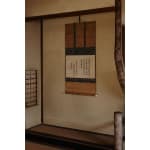Lanxi Daolong (1213–1278)
Words from the Record of Linji
Ink on paper, hanging scroll
Dated Kocho 2 (1262)
With authentication by Kohitsu Ryoi
Double boxed
Seal: Rankei
34.8 x 51.3 cm
109 x 53 cm (overall)
Dated Kocho 2 (1262)
With authentication by Kohitsu Ryoi
Double boxed
Seal: Rankei
34.8 x 51.3 cm
109 x 53 cm (overall)
Further images
Provenance
Collection of Nezu MuseumLiterature
Mokuroku. Tokyo: Nezu Museum and Tokyo Bijutsu Kaikan, 1943.
Lanxi Daolong, known in Japan as Rankei Doryu, was a renowned Chinese Linji Chan (J. Rinzai Zen) monk of the Songyuan lineage of the Yangqi branch. He studied under Chan masters such as Wuzhun Shifan, and later inherited the lineage of Wuming Huixing. In 1246, he arrived in Dazaifu on a Japanese merchant ship to propagate Zen in Japan. He rst served at Engaku-ji temple in Chikuzen Province before going to Kyoto, where he rekindled his friendship with Abbot Chikyo of Raigo-in, a subtemple of Sennyu-ji, who had studied in China. In Kyoto, Chikyo advised Daolong to move to Kamakura, where the latter received the patronage of the Regent Hojo Tokiyori and resided in the temple Joraku-ji. In 1252, Daolong founded Kencho-ji temple at the request of Tokiyori. In 1265, he became the abbot of Kennin-ji temple in Kyoto by imperial decree, though three years later, he returned to Kencho-ji. With the deep devotion of Tokiyori, Daolong became an important figure in establishing the foundation of Zen in Kamakura. He received the posthumous title “Daikaku Zenji” (Zen Master of Great Awakening) from the abdicated Emperor Kameyama (1249–1305). This purportedly was the beginning of the tradition of emperors bestowing posthumous titles to prominent Zen masters in Japan.
Lanxi Daolong brushed this work in 1262 at the age of sixty, while he was the abbot of Kencho-ji. The calligraphy was made for his disciple Tokuzo su on the occasion of a memorial for his ancestors. The words here come from the discourse in section eight of Linji lu, the recorded sayings of Chan master Linji Yixuan (J. Rinzai Gigen, d. 866), the founder of the Linji Chan sect, and basically says:
One man walks along the way (to attain enlightenment) in perpetuity, though he never leaves home. One man
always leaves home, though he is not on the way. So who deserves the offerings of those in the human and
heavenly realms?
The orthodox Southern Song-style kaisho, or block script, here, recalls that of Zhao Mengfu (1254–1322). This calligraphy is listed in the 1943 auction cata- logue of Nezu Museum in Tokyo, and is thought to be among the works that the museum acquired during the anti-Buddhist movement in the Meiji period (1868–1912).
Lanxi Daolong (Chan priest; 1213−1278)
Also known as Rankei Doryu; Ran (family name); Daikaku Zenji (posthumous).
Chinese Linji school Chan priest who traveled to Japan during the Kamakura period. Born in Peijiang in present-day Sichuan province, and became a disciple of the Chan master Wuming Huixing (Mumyo Esho) in early years. Traveled to Japan, and served at Raigo-in subtemple at Sen’nyu-ji temple in Kyoto and Jufuku-ji temple in Kamakura. Appointed the founding abbot of Kencho-ji temple in Kamakura by the regent Hojo Tokiyori. Also taught Gosaga-joko (abdicated emperor Gosaga) the Buddhist teaching at Ken’nin-ji temple in Kyoto. Later returned to Kencho-ji temple on Hojo Tokiyori’s request. Selected the site of Engaku-ji temple. Laid the foundation of Kamakura Zen Buddhism and remained influential greatly posthumous.
Lanxi Daolong brushed this work in 1262 at the age of sixty, while he was the abbot of Kencho-ji. The calligraphy was made for his disciple Tokuzo su on the occasion of a memorial for his ancestors. The words here come from the discourse in section eight of Linji lu, the recorded sayings of Chan master Linji Yixuan (J. Rinzai Gigen, d. 866), the founder of the Linji Chan sect, and basically says:
One man walks along the way (to attain enlightenment) in perpetuity, though he never leaves home. One man
always leaves home, though he is not on the way. So who deserves the offerings of those in the human and
heavenly realms?
The orthodox Southern Song-style kaisho, or block script, here, recalls that of Zhao Mengfu (1254–1322). This calligraphy is listed in the 1943 auction cata- logue of Nezu Museum in Tokyo, and is thought to be among the works that the museum acquired during the anti-Buddhist movement in the Meiji period (1868–1912).
Lanxi Daolong (Chan priest; 1213−1278)
Also known as Rankei Doryu; Ran (family name); Daikaku Zenji (posthumous).
Chinese Linji school Chan priest who traveled to Japan during the Kamakura period. Born in Peijiang in present-day Sichuan province, and became a disciple of the Chan master Wuming Huixing (Mumyo Esho) in early years. Traveled to Japan, and served at Raigo-in subtemple at Sen’nyu-ji temple in Kyoto and Jufuku-ji temple in Kamakura. Appointed the founding abbot of Kencho-ji temple in Kamakura by the regent Hojo Tokiyori. Also taught Gosaga-joko (abdicated emperor Gosaga) the Buddhist teaching at Ken’nin-ji temple in Kyoto. Later returned to Kencho-ji temple on Hojo Tokiyori’s request. Selected the site of Engaku-ji temple. Laid the foundation of Kamakura Zen Buddhism and remained influential greatly posthumous.







